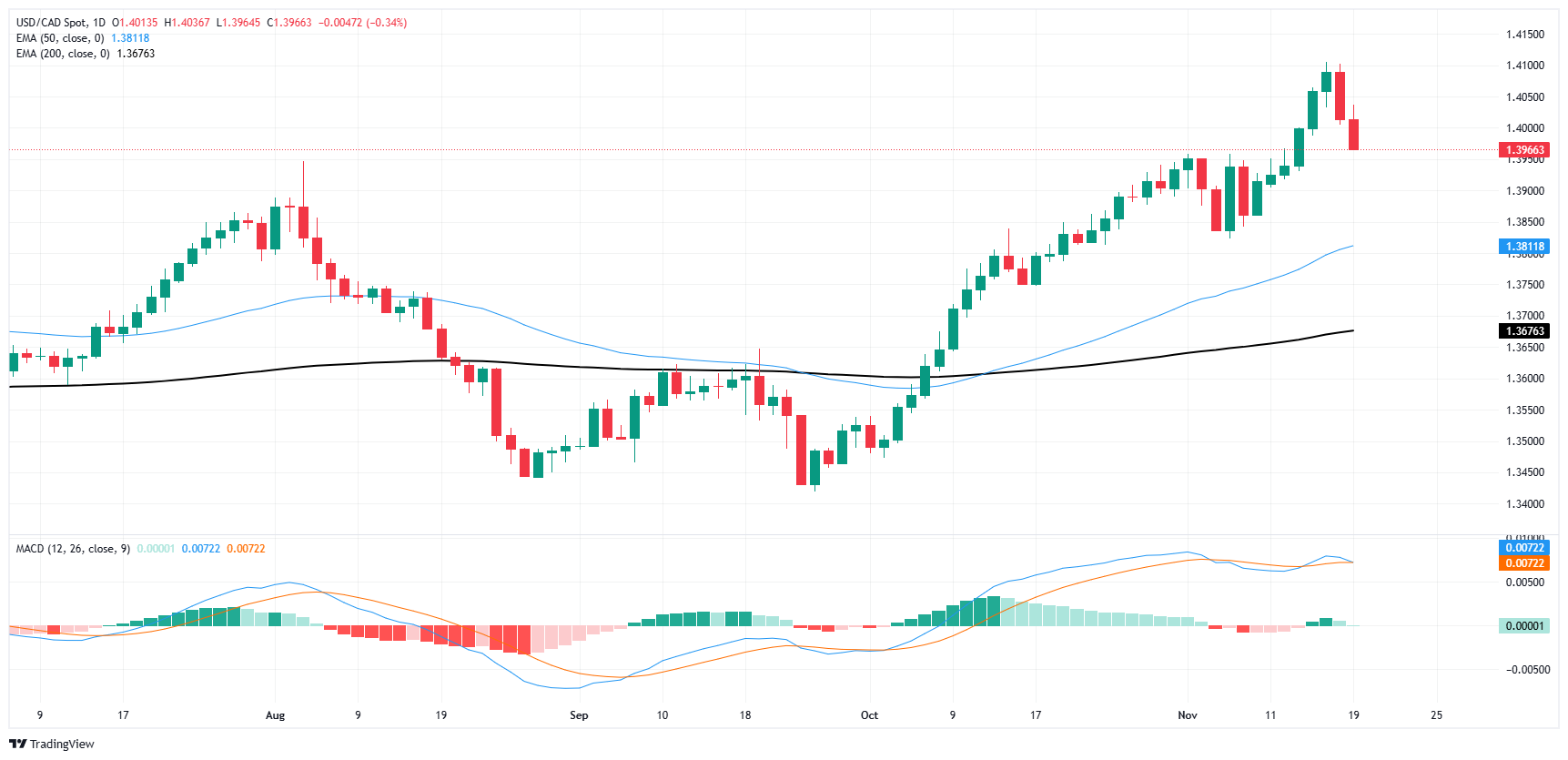- The Canadian dollar gained another 0.3% on Tuesday.
- Canada reported higher-than-expected CPI inflation in October.
- A re-acceleration of inflation is raising hopes of more rate cuts by the BoC.
The Canadian Dollar (CAD) caught bids on Tuesday, rising for the second day in a row against the US Dollar after Canadian Consumer Price Index (CPI) inflation rose again in October. The CAD is gaining ground against the US Dollar, regaining a full percentage point with more gains on the horizon as the Loonie regains ground after hitting 54-month lows near 1.4100.
Canada’s entire set of CPI inflation figures beat forecasts on Tuesday, recording higher values across the board and testing the Bank of Canada’s (BoC) resolve on interest rates. The numbers are still on the low side of recent history; The headline annualized CPI hit a three-year low last month. However, the rebound in numbers will still serve as a warning to the BoC, which is already on a path of accelerating rate cuts as the Canadian economy falters in the post-pandemic environment.
Daily Market Summary: Canadian Dollar Rebounds from the Brink
- The Canadian dollar rallied another third of a percentage point on Tuesday, dragging bids decisively below the 1.4000 level on the USD/CAD chart.
- Canadian headline CPI inflation accelerated to 2% year-on-year in October, accelerating from the previous three-year low of 1.6% and beating the forecast of 1.9%.
- The BoC’s core CPI inflation measure also accelerated in annualized terms, standing at 1.7% year-on-year from 1.6% in the previous period.
- Headline CPI inflation rose to 0.4% monthly in October after September’s -0.4% contraction. Median market forecasts pointed to 0.3%.
- Except for the retail sales numbers due out on Friday, Canada is functionally done with any impactful releases for this week.
Canadian Dollar Price Forecast
The Canadian Dollar (CAD) extended a short-term rally for a second day, recovering from the brink after hitting 54-month lows late last week. The USD/CAD chart has pulled back below the 1.4000 level amid the Loonie bounce, pulling back a full percentage from nearly five-year highs just north of 1.4100.
Despite the short-term recovery, it is still too early to declare that a trend reversal is underway. USD/CAD price action continues to make gains on the chart above the 50-day EMA, although CAD bulls will feel invigorated as the pair appears set to continue bouncing in a sideways trend. of several years on the higher time frames.
USD/CAD Daily Chart
The Canadian Dollar FAQs
The key factors that determine the price of the Canadian dollar (CAD) are the level of interest rates set by the Bank of Canada (BoC), the price of oil, Canada’s main export product, the health of its economy, inflation and the trade balance, which is the difference between the value of Canadian exports and its imports. Other factors are market confidence, that is, whether investors bet on riskier assets (risk-on) or look for safe assets (risk-off), with the risk-on being positive for the CAD. As its largest trading partner, the health of the US economy is also a key factor influencing the Canadian dollar.
The Bank of Canada (BoC) exerts significant influence over the Canadian Dollar by setting the level of interest rates that banks can lend to each other. This influences the level of interest rates for everyone. The BoC’s main objective is to keep inflation between 1% and 3% by adjusting interest rates up or down. Relatively high interest rates are usually positive for the CAD. The Bank of Canada can also use quantitative easing and tightening to influence credit conditions, with the former being negative for the CAD and the latter being positive for the CAD.
The price of oil is a key factor influencing the value of the Canadian Dollar. Oil is Canada’s largest export, so the price of oil tends to have an immediate impact on the value of the CAD. Generally, if the price of oil rises, the CAD also rises, as aggregate demand for the currency increases. The opposite occurs if the price of oil falls. Higher oil prices also tend to lead to a higher probability of a positive trade balance, which also supports the CAD.
Although inflation has traditionally always been considered a negative factor for a currency, as it reduces the value of money, the opposite has actually happened in modern times, with the relaxation of cross-border capital controls. Higher inflation often leads central banks to raise interest rates, attracting more capital inflows from global investors looking for a lucrative place to store their money. This increases the demand for the local currency, which in the case of Canada is the Canadian Dollar.
The published macroeconomic data measures the health of the economy and may have an impact on the Canadian dollar. Indicators such as GDP, manufacturing and services PMIs, employment and consumer confidence surveys can influence the direction of the CAD. A strong economy is good for the Canadian dollar. Not only does it attract more foreign investment, but it may encourage the Bank of Canada to raise interest rates, resulting in a stronger currency. However, if economic data is weak, the CAD is likely to fall.
Source: Fx Street
I am Joshua Winder, a senior-level journalist and editor at World Stock Market. I specialize in covering news related to the stock market and economic trends. With more than 8 years of experience in this field, I have become an expert in financial reporting.







